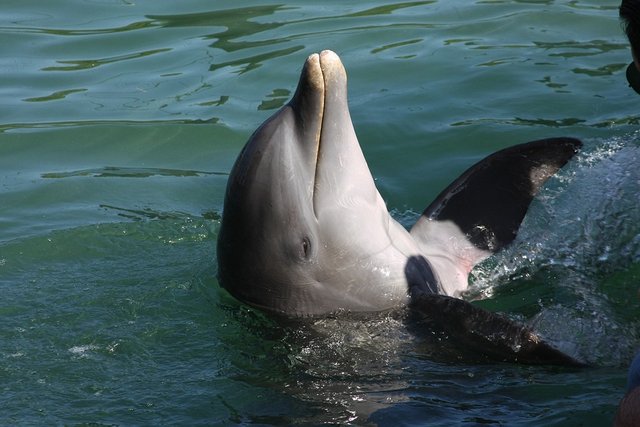Communication with Unmotivated Dolphins: Intelligence Part 4

During my research on the last article in this series, I read about a project to develop a shared language between humans and dolphins. SETI (Search for Extra Terrestrial Intelligence) was very interested in this project, as the difficulties we face when trying to communicate with dolphins are likely to be similar to those involved in communicating with an alien race. [1]. We can’t communicate vocally with dolphins as we do with birds (they don’t have vocal cords capable of making human speech) or with sign language as we do with apes (they don’t have hands). What dolphins do have is a very large brain and a highly complex social structure, both of which indicate they would have quite a lot to say to us if we could get around the practical difficulties.
The effort to develop a language together with another species is also a good answer to the persistent criticism in studies of animal intelligence that we are really just measuring their ability to act like a human.[2].
The Dolphin communication project is being conducted by a group called The Wild Dolphin Project. As the name indicates, they study a group of dolphins in their natural environment. One of their key principles is to disturb the dolphins as little as possible. They never feed them, and don’t interrupt the dolphin group when they are involved with tasks such as hunting or defending themselves against sharks. Adhering to these principles can make conducting experiments quite a bit more difficult, as we will discuss later.
Previous Research on Dolphin Communication

Dolphins communicate primarily through sound. They are able to make a wide range of clicks and whistles, some of which are at a pitch too high for humans to hear. They also use some body language, such as pointing to objects with their head. Each dolphin has a unique ‘signature’ whistle, which can function like a name. Dolphins have an excellent memory for the signature whistles of other dolphins they have met, and can mimic the whistles of others when they want to communicate with them. [3]They have shown the ability to understand some complex language constructions, such as carrying out instructions in accordance with word order in a sentence [4]
The Wild Dolphin Project created a device for the dolphins and humans to use in communicating with each other. If you were a dolphin what kind of keyboard could you use? One that looks basically like this:

Dolphins are not good typists, their only method of hitting the keys is by smashing their face into it. Actually, it turns out they don’t like touching foreign objects at all, so they indicate they want to press a key by pointing their head at it. Therefore, the keys need to be very large and far apart so that we can be certain which one the dolphin wants to press. Each of the symbols on the keyboard represented an object the dolphins like to play with. One represented a piece of seaweed, and another a rope. In addition to the key, each play object was also represented by a 'whistle' sound. The sound was not one the dolphins used when communicating with each other, but was one they had no problem reproducing.[5]
The dolphins involved in the study had been observed playing with the objects in the past, sometimes allowing the humans to join in their game. When trying to get the dolphins to engage in communication, one human would hold the keyboard, while several others would model basic communication using the keyboard. For example, the four objects would be placed in the water inside jars. One human would get the attention of another human, then point to one of the symbols or play the appropriate whistle sound. The second human would then go and get the object represented by the symbol. In this way, the dolphins could learn the representations for each object, and each species could relay basic messages to the other such as ‘I want to play with the seaweed.’[5] From this basic foundation, greater complexity could be added until the point where we could add ‘humandolphin’ to the list of world languages. Things did not progress quite as planned however. Let’s have a look at the results of the study.
Results
There were several occasions when the human researchers were able to request the dolphins to bring them an object. After pushing the appropriate symbol or playing the whistle sound, the dolphins went to the sea floor to retrieve the object and dropped it in front of the humans at the surface. However, communication did not progress too far beyond this.
Experiment versus Observational Study
As The Wild Dolphin Project is well aware, this study does not meet the control requirements of a true experiment. Instead it can be classified as an observational study. Observational studies can have a lot of value. In animal studies two examples of common benefits are helping to generate hypotheses for experimental studies, and providing information about how the animal is likely to respond in different circumstances.
Denise Herzing, the director of The Wild Dolphin Project, has a Ted talk where she compares the dolphins to young children, talking about the importance of holding their attention. The technique of rewarding animals with food in order to elicit a certain behavior is as old as the domestication of dogs, dating back tens of thousands of years.

The Wild Dolphin Project principal of not disrupting the wild environment by feeding the dolphins is admirable, and has allowed the project to contribute a lot of information about how dolphins behave naturally. However it does make measuring the abilities of the dolphins very difficult: as reported in the study most of the time the dolphins were not particularly interested in the keyboard, and many times attempts to communicate with the dolphins ended when the dolphins simply got bored and swam away.
How can we make the humans a little more interesting?
Communication through the keyboard was too slow and clumsy to keep the dolphin's attention. The study recognized that the humans needed a quicker and more familiar way to respond to the dolphins.[5]
The dolphins need technologically and acoustically advanced tools both for their initiations and interactions, and humans need a real time acoustic interface to respond quickly.
Dolphins can’t pronounce human words, and we are equally bad at forming the sounds of their language. Machines may provide the answer. The ability of AI-powered computers to reproduce human speech has been rapidly improving, and some of the same technology can be applied to dolphin vocalizations.

Anyone who has watched a few Science Fiction movies will have seen a universal translator- a machine which can instantaneously translate your sentence into the language of the alien you are communicating with. Artificial intelligence pattern recognition algorithms are currently working on correlating dolphin vocalizations with behavior. Perhaps SETI is correct in its interest in the wild dolphin project, and the distant ancestor of a true future Universal Translator is currently learning how to whistle and click like a dolphin.
REFERENCES
http://www.wilddolphinproject.org/
https://www.seti.org/about-us/mission
https://en.wikipedia.org/wiki/Observational_study
Herman, L. Richards, D., Wolz, J. (1984). Comprehension of sentences by bottlenosed dolphins. Cognition 16, 2. 129-219. https://doi.org/10.1016/0010-0277(84)90003-9
Unmotivated would also describe a lot people at work. They also hate communicating.
Maybe after years of research we will finally understand dolphin speech and find out that what they really wanted to say to us was ' just give me my fish and leave me alone.'
Sounds about right. I bet there will be a lot more cursing than we realize. Flipper might have quite the foul mouth on him.
I wouldn't be surprised. Never completely trusted Flipper, he looks slippery
I thought I posted a comment here, but somehow lost it. To sort of repeat: I think dolphins are bored with us because they don't care about the universe of things that interest us. I don't think the issue is merely one of mechanics. It may be culture. Of course they're not interested in typing. We keep inviting them onto our terrain, to play with our toys. We may be framing the communication experiment from a narrow point of view--ours. Dolphins are nice, and patient. But even their patience has its limit. They get bored and return to more dolphin-relevant activities.
I always wonder if dolphins think we're silly :)
There definitely is a growing acceptance in studies of animal intelligence that we have been too narrow in definitions of what is intelligence, and what is intelligent behaviour. It is definitely helpful to look at things from the dolphin point of view. To them we must look like slow terrible swimmers who can only communicate by clumsy body language. I am excited by the possibility of using AI to decode their language and speak it back to them. That would make us a lot more interesting to the dolphins!
Delightful! We definitely need a more culturally neutral bridge. Maybe AI can do it. I have been reading about bee intelligence, and see that we run into the same kind of perspective block. I mean, they are so smart, and to us they're just invertebrates. My next blog, I think.
I love the respect you have for dolphins and their integrity as something apart, but not beneath us.
Hello @flyyingkiwi
Rich and well explained content. I have heard so much about human-dolphin communication but only hearsay and nothing as rich as this. Reading this, I am tempted to say Humans are gods! I mean how could one possibly figure out that one could communicate with dolphins, tried it and it worked!? This is amazing. I really wonder what future holds in this regard, man!!?
Always keep in touch.
Regards
@eurogee of @euronation and @steemstem communities
I'm also really excited to see what happens here over the next few years. We already have some artificial intelligence that can copy human speech so well it's hard to tell the difference. So it should be able to whistle and click back to the dolphins too. Of course we are still not sure what all those dolphins sounds mean, so it will take some time to figure that out!
We need an @dolphintranslatebot to come through here but perhaps we need, as you mention some AI to do it for us? Cool article!
We can call it the DolphinWhisperer. Let's hope it happens, I want to see what those dolphins have to say.
I'm keen. Oh @dolphinwhisperer how do I know if those dolphins playing in my wake want us to speed up or slow down?
It would be amazing to have a sort of translator to communicate with smart animals such as dolphins, but if this is possible this sounds like something that is decades or centuries from existing, still, the idea is exciting.
I think using AI to mimic the Dolphins sounds is not too far away, WaveNet can already do really convincing human speech. Of course figuring out what all those dolphins sounds mean would take a lot of time and resources, hopefully some well funded AI group will get interested in it.
I admit this was very interesting, creating a technology to allow us "talk" with dolphins. I'd love to see it some time soon and I wonder what other animal languages we would be able to speak in the future...
It really would be amazing to talk to the dolphins. I think if artificial intelligence continues to improve it could be done in the next few decades. Have to hope one of the big AI research groups takes it up as a challenge to show off what they can do
It would be awesome to achieve something like that! Have you come across any similar "experiments" with primates?
I guess you have heard of Koko the gorilla who could use sign language. Apparently there is quite a lot of controversy about how much she really knew. I will have to read more, will definitely do a post about her at some stage!
I don't remember exactly what was it I had read, to be honest, but I remember the idea of communicating with primates.
I'd love to see what you can find! :D
Hi @flyyingkiwi!
Your post was upvoted by utopian.io in cooperation with steemstem - supporting knowledge, innovation and technological advancement on the Steem Blockchain.
Contribute to Open Source with utopian.io
Learn how to contribute on our website and join the new open source economy.
Want to chat? Join the Utopian Community on Discord https://discord.gg/h52nFrV
This is just as interesting as reading about intelligence quotient.
A lot of facts here.
Nice piece I have read today @flyyingkiwi
Dolphins are actually very intelligent, u have read a lot of papers about this creatures.
Dolphins are very difficult for us to understand since they live in the sea and communicate in a totally different way. I think technology can help us communicate better, let's hope someone with a lot of money invests in Dolphin research!
russia has an attack dolphin program
America too. Its about time New Zealand had one. We have plenty of dolphins
Congratulations! Your post has been selected as a daily Steemit truffle! It is listed on rank 23 of all contributions awarded today. You can find the TOP DAILY TRUFFLE PICKS HERE.
I upvoted your contribution because to my mind your post is at least 13 SBD worth and should receive 78 votes. It's now up to the lovely Steemit community to make this come true.
I am
TrufflePig, an Artificial Intelligence Bot that helps minnows and content curators using Machine Learning. If you are curious how I select content, you can find an explanation here!Have a nice day and sincerely yours,

TrufflePigFollow @bible.com